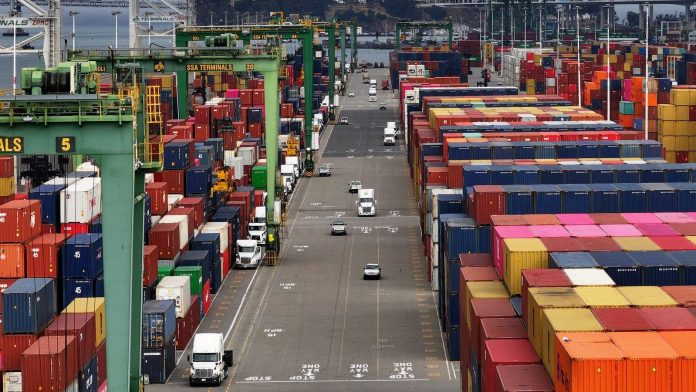In many respects US President Donald Trump achieved his aims by introducing a swath of tariffs with America’s main trading partners around the world.
The European Union has a population of 448 million compared to the US which has 340 million.
However, the US economy is larger.
Many have been surprised at the way Donald Trump has appeared to be able to dictate terms to Europe.
His announcement yesterday that he would commence the new tariff arrangements from 7 August appeared to be his decision with little input from the EU.
President of the European Commission Ursula Von Der Leyen has defended the deal, which will see tariffs of 15% imposed on EU goods.
There are two reasons why the EU did not want a full blown trade war with Mr Trump.
Firstly, European businesses were opposed to a prolonged period of tit-for-tat tariffs with enormously damaging consequences.
Secondly, if relations with Mr Trump soured, he could threaten to row back on defence commitments.
Many have been surprised at the way Donald Trump has appeared to be able to dictate terms to Europe
The EU is highly reliant on the US for arm supplies, funding for NATO and military support for Ukraine.
But looking at scale of tariffs imposed on other countries the EU’s 15% does not seem too damaging compared to India’s 25%, Canada’s 35% and Switzerland’s 39%.
Most of the US’ main trading partners have rates of 15% or 20%.
The exception is the UK’s 10% tariff. However, this is not an all-inclusive rate.
In other words, other rates can be added to it.
Nor does Britain have a written agreement capping pharmaceutical tariffs unlike the EU.
It is worth bearing in mind that while tariffs on European goods go up, Mr Trump stated the EU would be “opening up their countries at zero tariffs” for US exports.
Unanswered questions
From the Irish point of view there are still many unanswered questions.
There is no agreement on alcohol exports to the US.
That sector was expected to be covered by a zero-for-zero tariff arrangement but that has not yet been confirmed.
This is critical for Ireland’s whiskey industry and the EU’s wine exports.
It seems clear that pharmaceuticals and computer chips will face tariffs of up to 15%, but the timing is still uncertain.
Both are subject of so-called Section 232 investigations because Mr Trump believes the US’ use of imports is a national security issue.
Bank of Ireland pointed out that pharmaceuticals are a relatively inelastic product
Tánaiste Simon Harris said the tariffs for sectors under investigation will not become clear until those processes are concluded.
For pharmaceuticals that is expected to happen in two weeks.
But the fact that the EU-US agreement won’t exceed 15% does provide some clarity for the industry.
Bank of Ireland pointed out that drugs are relatively inelastic, which means if prices go up people still buy them because they are prescribed by doctors.
The new swath of tariffs come at a time when the dollar has been weakening and making EU exports to the US more expensive at the worst possible time.
Then there is the question of what this all means for the Irish economy.
In March, the Department of Finance and the Economic Social Research Institute published research on the impact of tariffs on the Irish economy.
It looks at a range of scenarios from tariffs of 10% to 25%.
Based on that analysis, officials at the Department of Finance told business leaders yesterday that the economy would continue to expand, but at a slower pace than previously expected.
Employment will grow but at a slower rate.
The Government will now have to decide how all this will impact the Budget in October.
But while Mr Trump may believe he has achieved his aims on tariffs, in the long run his actions carry the risk of higher inflation in the US and undermining the American economy.





